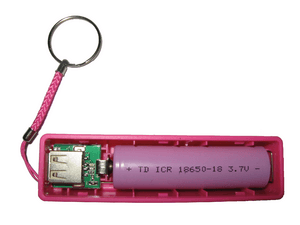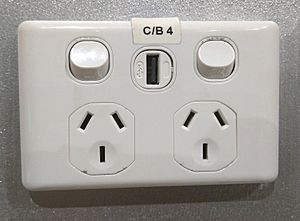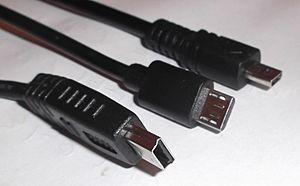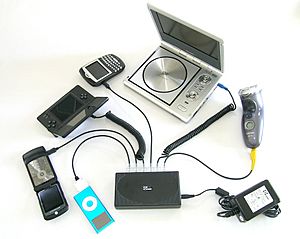Battery charger facts for kids
A battery charger is a special device that helps you use a battery again after it runs out of power. It works by sending electric current back into the battery. But remember, only rechargeable batteries can be charged!
You can find battery chargers everywhere. They are used for mobile phones, electric vehicles, and even laptops.
Contents
How Battery Chargers Work
Simple Chargers
Simple chargers are the most basic type. They send a steady flow of electricity to the battery. These chargers are usually cheap. However, they don't change how they charge based on how full the battery is. This means if you leave a battery on a simple charger for too long, it can get damaged from overcharging.
Fast Chargers
Fast chargers are designed to charge batteries quickly without harming them. They have special electronic parts that control the charging process. Many fast chargers also have a cooling fan to keep the battery from getting too hot. Some can even work as regular overnight chargers for certain types of batteries.
Wireless Chargers
Wireless chargers use a cool trick called electromagnetic induction to charge batteries. This means they send energy through the air without needing metal contacts. You just place your device on a charging pad! This is common for electric toothbrushes. It's super safe because there are no open electrical parts. Right now, this technology mostly works for smaller batteries.
Smart Chargers
A "smart charger" is different from a "smart battery." A smart charger can sense how much power a battery has and change its charging plan. It might check the battery's voltage, temperature, or how long it has been charging. This helps it decide the best way to charge and when to stop.
For some batteries, like Ni-Cd and NiMH ones, the voltage goes up as they charge. When they are full, the voltage actually drops a little. Smart chargers can notice this drop and stop charging. This helps prevent overcharging.
Many smart chargers will quickly charge a battery to about 85% of its power. Then, they switch to a slower "trickle charge" to fill it up completely. This takes a few more hours.
Motion-Powered Chargers
Imagine charging your phone just by moving! Some companies have made devices that charge batteries using human motion. One example uses a magnet that slides back and forth as you walk, creating electricity.
There are also pedal-powered chargers. These are often found in public places like airports or train stations. You can pedal a bike or use a special desk to charge your phone!
Pulse Chargers
Some chargers use "pulse technology." This means they send short bursts of electricity to the battery. These pulses are carefully controlled. This method can work for many different types and sizes of batteries.
With pulse charging, you can use higher amounts of electricity without making the battery too hot. For lead-acid batteries, this can even help break down harmful crystals, making the battery last longer.
Solar Chargers
Solar chargers turn light from the sun into electricity. They are often portable, so you can take them with you on trips. Larger solar chargers are called solar panels and can be connected to a home's power system. Portable solar chargers are great for charging devices when you're away from regular power outlets, like in a car or boat.
Timer Chargers
Timer chargers stop charging after a set amount of time. In the past, these were common for certain types of batteries. The charging time was usually set for a specific battery size. If you used a smaller battery, it would overcharge. If you used a larger battery, it wouldn't get fully charged. This made them less useful as battery technology improved.
Trickle Chargers
A trickle charger sends a very small amount of electricity to the battery. They are often used for small batteries or to keep larger batteries, like those in cars or boats, fully charged. Some trickle chargers can be left connected to the battery all the time without causing damage. These are often called smart chargers too. But be careful, some batteries, like most Li-ion ones, can be damaged by constant trickle charging.
Universal Chargers
The most advanced chargers are called universal battery charger-analyzers. These are used for important jobs, like military or aviation batteries. They can be programmed to charge all kinds of batteries using very specific methods. They can also test and analyze how much power a battery has.
USB Chargers
Many devices today, like cell phones, digital audio players, and tablet computers, can be charged using a USB cable. This is because USB ports can provide a small amount of power.
Power Banks
Power banks are portable devices that hold power in their own batteries. You can use them to charge your smartphone or tablet when you're on the go. They usually recharge using a USB power supply. Inside, a power bank has Lithium-ion or Lithium-Polymer batteries and a special circuit board that keeps them safe.
Power banks have different features:
- Capacity: This tells you how much power the power bank can store. It's measured in mAh (milli Ampere-hour).
- Charging and Discharging: Some power banks can charge your device while they are also being charged themselves.
- USB Ports: They can have one or more USB ports to charge multiple devices at once.
- Output Current: This shows how fast the power bank can charge your device. Higher numbers mean faster charging.
- Safety: Good power banks have safety features to protect against overcharging, overheating, and short circuits.
- LED Lights: Small LED lights often show how much power is left in the power bank.

Compatibility
Even though USB chargers are common, there can still be some issues.
- Connectors: Devices use different types of USB connectors, like Micro USB, Mini USB, or lightning connector. Make sure the charger's connector matches your device!
- Charging Speed: Some chargers are "smart" and can charge faster, while others are "dumb" and charge slower. Using the wrong type might mean your device charges very slowly, or not at all.
Where Chargers Are Used
Vehicle Battery Chargers
There are two main types of chargers for vehicles:
- Car Starter Batteries: These chargers are used to recharge the starter battery in a regular car. They often use a special "3-stage" charging process.
- Electric Vehicle Batteries: These chargers are for the large battery packs in electric vehicles. You can find special charging stations for them.
Chargers for car batteries come in different sizes. Small ones (up to 2 amps) are good for keeping a parked car's battery charged. Larger ones (10-15 amps) can recharge a car battery that has run down. Big garages have very powerful chargers that can fully charge a battery in an hour or two.
Electric Vehicle Charging Stations
Public electric vehicle charging stations can provide a lot of power, allowing EVs to recharge much faster than with a home charger. Some advanced systems even allow for "non-contact magnetic charging." This means the car can get power wirelessly from cables hidden under the road!
Mobile Phone Chargers
Most "mobile phone chargers" are actually just power adapters. The real charging parts are usually inside the phone itself. Older phone chargers were all very different, with many kinds of plugs and power levels. This made it hard to use one charger for different phones.
Now, many countries are trying to make a single standard for mobile phone chargers using the USB standard. This means that soon, most new phones will use the same microUSB charger, making things much easier!
Large Battery Systems
Big buildings like phone companies, power plants, and computer centers use huge backup batteries. These are called "stationary battery plants." They have special chargers that are always connected. These chargers keep the batteries ready to power important systems if the main electricity goes out. They are very reliable and often have backup systems themselves.
Making Batteries Last Longer
How you charge a battery can affect how long it lasts. It depends on the type of battery.
- NiCd Batteries: These batteries used to have a "memory effect." This meant they would "forget" their full capacity if not fully discharged sometimes. So, it was recommended to fully drain them once a month.
- Lithium-ion Batteries: Most modern phones, laptops, and electric cars use Lithium-ion batteries. These batteries last longest if you charge them often and avoid letting them run completely empty. If they get too low, they can be permanently damaged. That's why most Li-ion batteries have a safety feature that turns them off if the voltage drops too much.
- Lead-Acid Batteries: These are found in cars, boats, and other vehicles. They don't have a "memory effect." However, they can develop "sulfation" over time, which is a chemical reaction that harms the battery. Using a "maintenance charger" to keep them always fully charged can help them last much longer by preventing this problem.
Images for kids
See also
 In Spanish: Cargador de baterías para niños
In Spanish: Cargador de baterías para niños
















